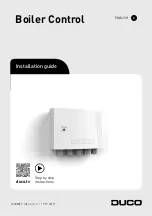
7
Figure 6: Recommended Bypass Piping
Figure 5: Recommended Piping for Combination
Heating & Cooling (Refrigeration)
Systems
Figure 5a: Internal Water Piping System Diagram
Install pipe tee between circulator and boiler return
along with second tee in supply piping as shown in
Figure 4. Bypass should be same size as the supply and
return lines with valves located in bypass and supply
outlet as illustrated in Figure 4 in order to regulate
water fl ow to maintain higher boiler water temperatures.
After the boiler is operational (reference Section VII.
System Start-Up) set by-pass and boiler supply valves
to half throttle position to start. Operate boiler until
system water temperature reaches normal operating
range.
Adjust valves to provide 180° to 200°F supply water
temperature. Opening the boiler supply valve will raise
system temperature, while opening the by-pass valve
will lower system supply temperature.
G.
A hot water boiler installed above radiation level
must be provided with a low water cut-off device as
part of installation.
If a low water cut-off is required, it must be mounted in
the system piping above the boiler.
The minimum safe water level of a hot water boiler is
just above the highest water containing cavity of the
boiler; that is, a hot water boiler must be full of water to
operate safely.
H.
Oil, grease, and other foreign materials
which
accumulate in new hot water boilers and a new or
reworked system should be boiled out, and then
thoroughly fl ushed. A qualifi ed water treatment
chemical specialist should be consulted for
recommendations regarding appropriate chemical
compounds and concentrations which are compatible
with local environmental regulations.
I.
After the boiler and system have been cleaned and
fl ushed,
and before refi lling the entire system add
appropriate water treatment chemicals, if necessary, to
bring the pH between 7 and 11.
It is required to perform a long term pressure test of the
hydronic system, the boiler should fi rst be isolated to
avoid a pressure loss due to the escape of air trapped in
the boiler.
To perform a long term pressure test including the
boiler, ALL trapped air must fi rst be removed from the
boiler.
A loss of pressure during such a test, with no visible
water leakage, is an indication that the boiler contained
trapped air.








































